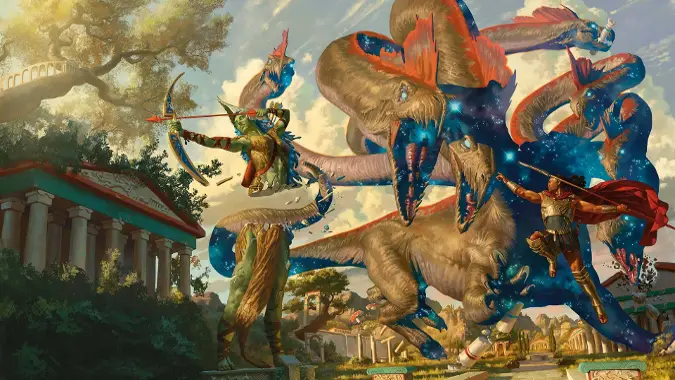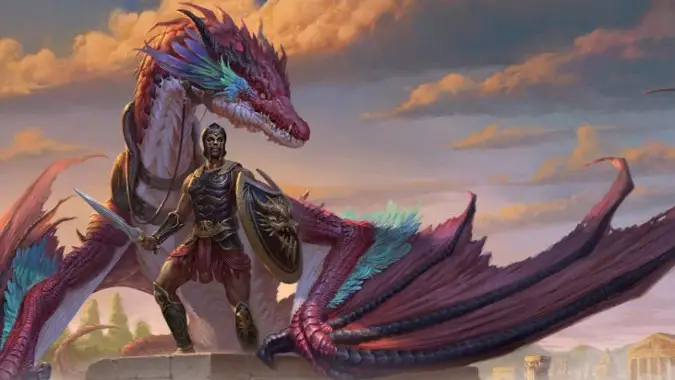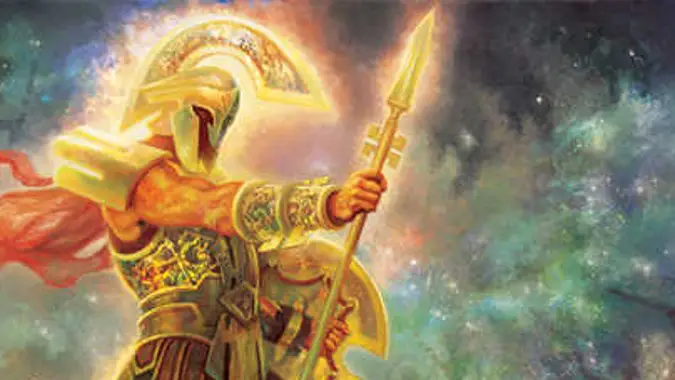The Mythic Odysseys of Theros sourcebook may change the assumptions of your D&D campaign

Mythic Odysseys of Theros is now available digitally on D&D Beyond, ahead of its July physical release, and that means we get to take a look at a campaign setting rooted in concepts borrowed not from the standard Tolkien-inspired generic medieval world, but instead from a more mythical, classical idea. It’s heavily inspired by ancient Greek myths and the epics of Homer, filtered through the core concepts of Dungeons and Dragons, and it is not even remotely the first time a published D&D setting has decided to depart from those tropes.
Of course, some of them have been unfortunately named — the old AD&D Oriental Adventures for example, which came back in both 2nd and 3rd Edition. I would rate the 3rd Ed. version as one of the best D&D supplements of its time despite the name (but really, seriously, it’s a terrible name) and the Mahasarpa campaign for that supplement by James Wyatt was one of the best examples of taking a D&D campaign setting off the Tolkien track and into some really interesting, evocative and non-generic fantasy directions. Similar to Mythic Odysseys of Theros, it used the myths and legends of the Indian subcontinent and parts of Southeastern Asia to inspire and create something that still plays like the game we know, but has a completely different and far more unique style and flavor. Done with a bit of care, you can do so as well.

Let your Odysseys be Mythic — literally
Looking at Theros, one of the ways it differentiates itself is by the basic conceit. Theros is a land with the dreams and subconscious beliefs of the people can etch their way into the world, prophecies are self fulfilling, and even the gods exist because enough people dreamed them up. It’s not a case of an illusion, but rather a metaphor for how belief systems start with a kernel of belief and grow from there, but it makes Theros feel different from worlds like Faerun or Greyhawk. The gods are no less powerful, but their origin is informative of the kind of world of pure myth you’re stepping into, and it also explains a concept from classical Greek myth that’s very non-Tolkienian.
We’ll use Heracles as an example. He moves from a culture hero, just one of many descended from a god, into a near-universal legendary being who helps the gods fight the giants in the Gigantomachy, and finally a divine being himself as more and more people in Ancient Greece heard and embellished his legends.
When trying to deviate from D&D‘s norms while preserving the feel of the game, think about what in particular you’re making the default. Another good example of a setting that moves away from the generic western fantasy tropes is Eberron, which first came into being as a 3rd Edition setting, and has been adapted for both 4th and 5th Edition D&D. Eberron presents a world where everything we think of as standard D&D exists, but the setting is one where a long war has recently ended with the destruction of a continent spanning nation, the establishing of several independent states, and the complete annihilation of one of the previously warring countries seeking to dominate the world. There are airships and magic trains and clandestine espionage, and it feels very much like a fantasy fusion of a Len Deighton novel and the pulp storytelling of writers like Clark Aston Smith, C.L. Moore and even Edgar Rice Burroughs. If you wanted a D&D game that evoked the suspicion and paranoia of the period between 1918 and 1930, Eberron could well be your jam.

You can range across the world for inspiration
Now, there’s nothing wrong with letting your D&D campaign be generic western fantasy, if that’s what you want to do. But if you’re interested in deviating, it’s always helpful to understand how you’re going to change things, and specifically, what you’re going to base your game on. Instead of Lord of the Rings, you could use Romance of the Three Kingdoms or the Popol Vuh as your initial inspiration. You could decide you wanted to run a campaign based in and around a global war, such as the conflict between English and French power during the 18th and 19th centuries culminating in the Napoleonic Wars, or even make a fantasy version of the American Civil War if you wanted to, or you could dig into Celtic or Vedic sources like the Mabinogion or the Rig Veda.
One thing that Mythic Odysseys of Theros does is give you a blueprint for how to adapt without directly copying those sources — using myths and legends we have to inspire the creation of figures like those gods, monsters and heroes, but not identical to them. The Archons of Trax serve as figures similar to the Titans of Greek Mythology, for example. The epic tales mentioned in the book — The Akroan War, The Callapheia, and The Theriad — are not just inspired by actual epics like Thesiod’s Theogony or Homer’s Iliad and Odyssey, they also serve as a means to establish the details of the campaign setting as a whole, and thus, let your players know how things differ.
However you choose to use Mythic Odysseys of Theros, whether it’s as a sourcebook for a new campaign or as inspiration for your own worldbuilding, it’s always helpful to remember that you’re not limited to any one source — you can find a solid campaign idea in a documentary about Prohibition or through repeated watching of Avatar the Last Airbender, which, I mean come on, it’s a perfect D&D campaign. A group of youngsters on a worldwide journey to learn new powers and get strong enough to defeat a nation’s sadistic end boss? For that matter, the 90’s Mummy franchise, especially the first two movies, reeks of a D&D campaign just waiting for you to come along and argue with your friends about which class each character is. Ardeth Bey is a Ranger, Rick is a Fighter, Eevie is a Rogue, Imhotep is a Lich with a lot of Cleric or Druid levels — it writes itself. Imhotep is the villain of the first campaign, and he comes back as an antagonist in the second where the Scorpion King is the main villain.
Theros helps by showing us how a game can move really far away from the core assumptions of D&D while remaining exactly that. It’s worth picking up just to see how it can be changed up.
Please consider supporting our Patreon!
Join the Discussion
Blizzard Watch is a safe space for all readers. By leaving comments on this site you agree to follow our commenting and community guidelines.
 @MatthewWRossi
@MatthewWRossi



